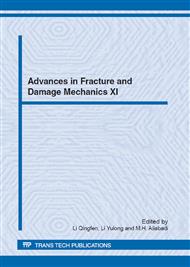p.589
p.593
p.597
p.601
p.605
p.609
p.613
p.617
p.621
Evaluation of Setting Time in Ultra High Performance Concrete
Abstract:
Ultra high performance concrete (UHPC), characterized by a high strength and high ductility, is also subjected to large shrinkage due to its low water-to-binder ratio and its large content in high fineness materials. The large amount of autogenous shrinkage of UHPC can induce crack on structural member when it was restrained with reinforcement and form. However, shrinkage of UHPC in plastic state is not generating confining stress, which is the main cause of initial crack. Normally, the setting time in concrete is an index to distinguish shrinkage which occur confining stress or not. An estimation of setting time is conducted in compliance with ASTM C 403 till now however, that test standard reveals error of results due to discordance of test condition as following with concrete type. This study therefore evaluated setting time of UHPC through the modified test method which was proposed by KICT. Test results and analyses proved a discrepancy of setting time between ASTM and proposed method. The proposed method put faith in evaluation of setting time in accordance with UHPC.
Info:
Periodical:
Pages:
621-624
Citation:
Online since:
November 2012
Authors:
Price:
Сopyright:
© 2013 Trans Tech Publications Ltd. All Rights Reserved
Share:
Citation:


